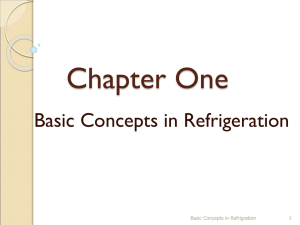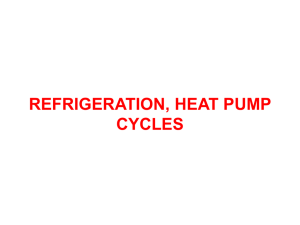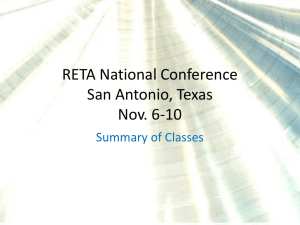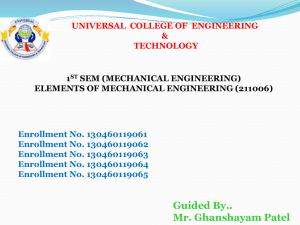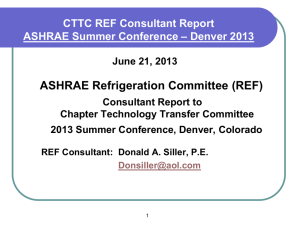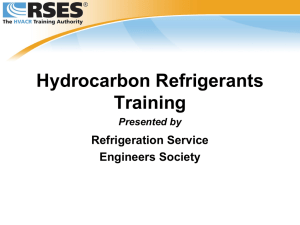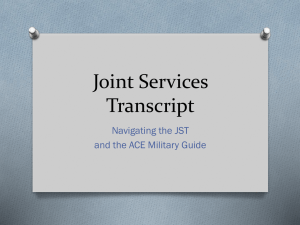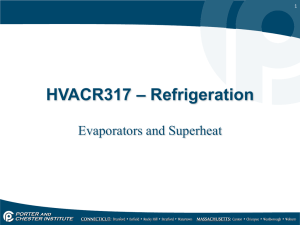05.refrigeration - Universiti Teknologi Malaysia
advertisement
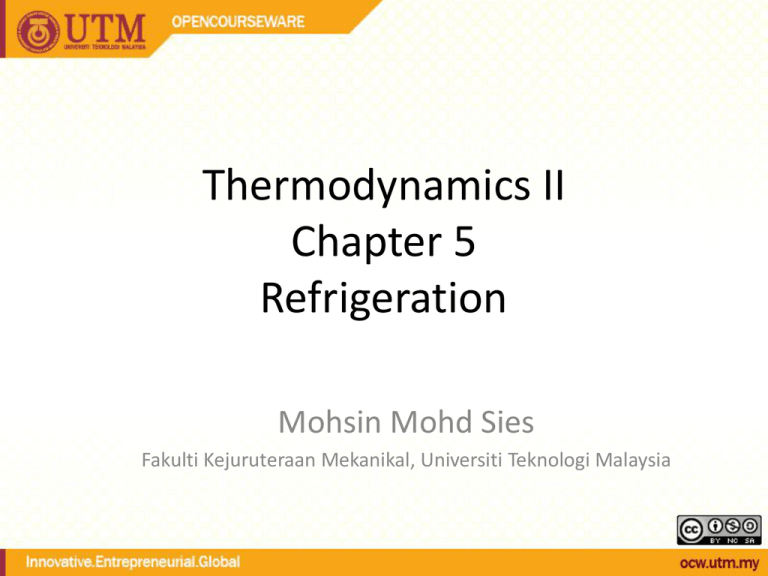
Thermodynamics II Chapter 5 Refrigeration Mohsin Mohd Sies Fakulti Kejuruteraan Mekanikal, Universiti Teknologi Malaysia Objectives • Introduce the concepts of refrigerators and heat pumps and the measure of their performance. • Analyze the ideal vapor-compression refrigeration cycle. • Analyze the actual vapor-compression refrigeration cycle. • Review the factors involved in selecting the right refrigerant for an application. • Discuss the operation of refrigeration and heat pump systems. • Evaluate the performance of innovative vapor-compression refrigeration systems. • Introduce the concepts of absorption-refrigeration systems. 2 Introduction • Refrigeration is the process of removing heat from an enclosed space, or from a substance, and rejecting it to an environment. • The primary purpose of refrigeration is lowering the temperature of the enclosed space or substance and then maintaining that lower temperature. • The term cooling refers generally to any natural or artificial process by which heat is dissipated. The process of artificially producing extreme cold temperatures is referred to as cryogenics Methods of refrigeration • Can be classified as non-cyclic, cyclic and thermoelectric. • Non-cyclic refrigeration - cooling is accomplished by melting ice or by subliming dry ice (frozen carbon dioxide). Are used for small-scale refrigeration i.e. laboratories and workshops, or in portable coolers. • Cyclic refrigeration - Consists of a refrigeration cycle, heat is removed from a low-temperature space/source and rejected to a high-temperature sink with the help of external work • Cyclic refrigeration can be classified as Vapor cycle and Gas cycle • Vapor cycle refrigeration can further be classified as: – Vapor-compression refrigeration – Vapor-absorption refrigeration Methods of refrigeration • Gas cycle - Air is most often the working fluid. The hot and cold gas-to-gas heat exchangers are used. Less efficient than the vapor compression cycle because the gas cycle works on the reverse Brayton cycle instead of the reverse Rankine cycle • Thermoelectric refrigeration - Thermoelectric cooling uses the Peltier effect to create a heat flux between the junction of two different types of materials. Commonly used in camping and portable coolers • Thermoacoustic refrigeration uses sound waves in place of a compressor to create cooling power. VAPOR COMPRESSION REFRIGERATION SYSTEM (VCRS) • Food Processing and storage Refrigerator • Building air conditioning system • Car air conditioning system • Water cooler • Ice cube maker • Low temperature drying process Operation of VCRS REFRIGERATORS AND HEAT PUMPS • The transfer of heat from a lowtemperature region to a hightemperature one requires special devices called refrigerators. • Another device that transfers heat from a low-temperature medium to a hightemperature one is the heat pump. • Refrigerators and heat pumps are essentially the same devices; they differ in their objectives only. • The objective of a refrigerator is to remove heat (QL) from the cold medium • The objective of a heat pump is to supply heat (QH) to a warm medium. Refrigerated Space, Ambient Temperatures vs Cycle Temperatures • Need to have delta_T to allow heat transfer • Evaporator temperature lower than refrigerated space temperature • Condenser temperature higher than ambient temperature Coefficient of Performance The performance of refrigerators and heat pumps is expressed in terms of the coefficient of performance (COP), defined as, 𝐷𝑒𝑠𝑖𝑟𝑒𝑑 𝑂𝑢𝑡𝑝𝑢𝑡 𝐶𝑜𝑜𝑙𝑖𝑛𝑔 𝐸𝑓𝑓𝑒𝑐𝑡 𝑄𝐿 𝐶𝑂𝑃𝑅 = = = 𝑅𝑒𝑞𝑢𝑖𝑟𝑒𝑑 𝐼𝑛𝑝𝑢𝑡 𝑊𝑜𝑟𝑘 𝐼𝑛𝑝𝑢𝑡 𝑊𝑛𝑒𝑡,𝑖𝑛 𝐶𝑂𝑃𝐻𝑃 𝐷𝑒𝑠𝑖𝑟𝑒𝑑 𝑂𝑢𝑡𝑝𝑢𝑡 𝐻𝑒𝑎𝑡𝑖𝑛𝑔 𝐸𝑓𝑓𝑒𝑐𝑡 𝑄𝐻 = = = 𝑅𝑒𝑞𝑢𝑖𝑟𝑒𝑑 𝐼𝑛𝑝𝑢𝑡 𝑊𝑜𝑟𝑘 𝐼𝑛𝑝𝑢𝑡 𝑊𝑛𝑒𝑡,𝑖𝑛 Both COPR and COPHP can be greater than 1. For fixed values of QL and QH COPHP = COPR + 1 THE REVERSED CARNOT CYCLE The reversed Carnot cycle is the most efficient refrig. cycle operating between TL and TH. It is not a suitable model for refrigeration cycles since processes 2-3 and 4-1 are not practical because Process 2-3 involves the compression of a liquid–vapor mixture, which requires a compressor that will handle two phases, and process 41 involves the expansion of high-moisture-content refrigerant in a turbine. Both COPs increase as the difference between the two temperatures decreases, that is, as TL rises or TH falls. Schematic of a Carnot refrigerator and T-s diagram of the reversed Carnot cycle. 11 REFERENCE COP The maximum COP of a refrigeration cycle operating between temperature limits of TL and TH Actual refrigeration cycles are not as efficient as ideal ones like the Carnot cycle because of the irreversibilities involved. But the conclusion we can draw from Eq. 11–9 that the COP is inversely proportional to the temperature difference TH - TL is equally valid for actual refrigeration cycles. 12 THE IDEAL VAPOR-COMPRESSION REFRIGERATION CYCLE Unlike the reversed Carnot cycle, • The refrigerant is vaporized completely before it is compressed • The turbine is replaced with a throttling device. This is the most widely used cycle for refrigerators, AC systems, and heat pumps. Schematic and T-s diagram for the ideal vapor-compression refrigeration cycle. 13 Analysis Each component is treated separately as open system with steady flow Steady-flow energy balance An ordinary household refrigerator. The P-h diagram of an ideal vaporcompression refrigeration cycle. 14 Problem Ideal and Actual Vapor-Compression Refrigeration Cycles 11–12 A refrigerator uses refrigerant-134a as the working fluid and operates on an ideal vapor-compression refrigeration cycle between 0.12 and 0.7 MPa. The mass flow rate of the refrigerant is 0.05 kg/s. Show the cycle on a T-s diagram with respect to saturation lines. Determine: a) the rate of heat removal from the refrigerated space, b) the power input to the compressor, c) the rate of heat rejection to the environment, and d) the coefficient of performance. Answers: (a) 7.41 kW, 1.83 kW, (b) 9.23 kW, (c) 4.06 15 Problem – Class Exercise Ideal and Actual Vapor-Compression Refrigeration Cycles 11–15 Consider a 300 kJ/min refrigeration system that operates on an ideal vapor-compression refrigeration cycle with refrigerant-134a as the working fluid. The refrigerant enters the compressor as saturated vapor at 140 kPa and is compressed to 800 kPa. Show the cycle on a T-s diagram with respect to saturation lines, and determine the: a) quality of the refrigerant at evaporator inlet, b) coefficient of performance, and c) power input to the compressor. 16 ACTUAL VAPOR-COMPRESSION REFRIGERATION CYCLE An actual vapor-compression refrigeration cycle differs from the ideal one owing mostly to the irreversibilities that occur in various components, mainly due to fluid friction (causes pressure drops) and heat transfer to or from the surroundings. As a result, the COP decreases. DIFFERENCES Non-isentropic compression Superheated vapor at evaporator exit Subcooled liquid at condenser exit Pressure drops in condenser and evaporator Schematic and T-s diagram for the actual vaporcompression refrigeration 17 cycle. Superheating and Subcooling • Superheating (at evaporator exit) – to ensure no liquid droplets enters compressor to damage it • Subcooling (at condenser exit) – to increase cooling capacity ΔT- Degree of superheating Problem Ideal and Actual Vapor-Compression Refrigeration Cycles 11–18 Refrigerant-134a enters the compressor of a refrigerator as superheated vapor at 0.14 MPa and 10°C at a rate of 0.12 kg/s, and it leaves at 0.7 MPa and 70°C. The refrigerant is cooled in the condenser to 24°C and 0.7 MPa, and it is throttled to 0.14 MPa. Disregarding any heat transfer and pressure drops in the connecting lines between the components, show the cycle on a T-s diagram with respect to saturation lines, and determine: a) the rate of heat removal from the refrigerated space, b) the power input to the compressor, c) the isentropic efficiency of the compressor, and d) the COP of the refrigerator. Answers: (a) 19.4 kW, 5.06 kW, (b) 82.5 percent, (c) 3.83 19 SELECTING THE RIGHT REFRIGERANT • Several refrigerants may be used in refrigeration systems such as chlorofluorocarbons (CFCs), ammonia, hydrocarbons (propane, ethane, ethylene, etc.), carbon dioxide, air (in the air-conditioning of aircraft), and even water (in applications above the freezing point). • R-11, R-12, R-22, R-134a, and R-502 account for over 90 percent of the market. • The industrial and heavy-commercial sectors use ammonia (it is toxic). • R-11 is used in large-capacity water chillers serving A-C systems in buildings. • R-134a (replaced R-12, which damages ozone layer) is used in domestic refrigerators and freezers, as well as automotive air conditioners. • R-22 is used in window air conditioners, heat pumps, air conditioners of commercial buildings, and large industrial refrigeration systems, and offers strong competition to ammonia. • R-502 (a blend of R-115 and R-22) is the dominant refrigerant used in commercial refrigeration systems such as those in supermarkets. 20 SELECTING THE RIGHT REFRIGERANT • CFCs allow more ultraviolet radiation into the earth’s atmosphere by destroying the protective ozone layer and thus contributing to the greenhouse effect that causes global warming. Fully halogenated CFCs (such as R-11, R-12, and R-115) do the most damage to the ozone layer. Refrigerants that are friendly to the ozone layer have been developed. • Two important parameters that need to be considered in the selection of a refrigerant are the temperatures of the two media (the refrigerated space and the environment) with which the refrigerant exchanges heat. • The saturation pressures of the refrigerant at the temperatures TH and TL of interest also affect the required Win. 21 SELECTING THE RIGHT REFRIGERANT 22 SELECTING THE RIGHT REFRIGERANT 23 • Ozone Depletion Potential (ODP) of a chemical compound is the relative amount of degradation it can cause to the ozone layer • Global Warming Potential (GWP) is a measure of how much a given mass of a gas contributes to global warming. GWP is a relative scale which compares the amount of heat trapped by greenhouse gas to the amount of heat trapped in the same mass of Carbon Dioxide. Refrigerant R-11 Trichlorofluoromethane R-12 Dichlorodifluoromethane R-13 B1 Bromotrifluoromethane R-22 Chlorodifluoromethane R-32 Difluoromethane R-113 Trichlorotrifluoroethane R-114 Dichlorotetrafluoroethane R-123 Dichlorotrifluoroethane R-124 Chlorotetrafluoroethane R-134a Tetrafluoroethane Ozone Depletion Potential (ODP) 1.0 1.0 10 0.05 0 0.8 1.0 0.02 0.02 0 Global Warming Potential (GWP) 4000 2400 1700 650 4800 3.9 0.02 620 1300 INNOVATIVE VAPOR-COMPRESSION REFRIGERATION SYSTEMS • The simple vapor-compression refrigeration cycle is the most widely used refrigeration cycle, and it is adequate for most refrigeration applications. • The ordinary vapor-compression refrigeration systems are simple, inexpensive, reliable, and practically maintenance-free. • However, for large industrial applications efficiency, not simplicity, is the major concern. • Also, for some applications the simple vapor-compression refrigeration cycle is inadequate and needs to be modified. • For moderately and very low temperature applications some innovative refrigeration systems are used. The following cycles will be discussed: • Cascade refrigeration systems • Multistage compression refrigeration systems • Multipurpose refrigeration systems with a single compressor • Liquefaction of gases 25 Multistage Refrigeration • Some industrial applications require moderately low temperatures, and the temperature range they involve may be too large for a single vapor compression refrigeration cycle to be practical. • A large temperature range also means a large pressure range in the cycle and a poor performance for a reciprocating compressor. • The long throttling process also results in decreased cooling capacity • One way of dealing with such situations is to perform the refrigeration process in stages, that is, to have two or more refrigeration cycles that operate in series. • Such refrigeration cycles are called cascade or multistage refrigeration cycles. Multistage Refrigeration • Cooling effect is achieved when liquid refrigerant vaporizes by absorbing heat from the cold space. • This means that the vapor produced during throttling does not contribute towards cooling because it is already vaporized. • Separating the vapor from the liquid in a flash chamber can increase the cooling effect • And the vapor can be used to cool the compressed refrigerant from the lower stage. This cooling will reduce the compressor work input. Cascade Refrigeration Systems A two-stage cascade refrigeration cycle is shown. The two cycles are connected through the heat exchanger in the middle, which serves as the evaporator for the topping cycle and the condenser for the bottoming cycle. Cascading improves the COP of a refrigeration system. Some systems use three or four stages of cascading. A two-stage cascade refrigeration system with the same refrigerant in both stages. 28 Cascade Refrigeration Systems (Analysis) Assuming the heat exchanger is well insulated and the kinetic and potential energies are negligible, the heat transfer from the fluid in the bottoming cycle should be equal to the heat transfer to the fluid in the topping cycle. • Thus, the ratio of mass flow rates through each cycle should be The coefficient of performance of the cascade system is 29 Multistage Compression Refrigeration Systems When the fluid used throughout the cascade refrigeration system is the same, the heat exchanger between the stages can be replaced by a flash chamber since it has better heat transfer characteristics. A two-stage compression refrigeration system with a flash chamber and mixing chamber. 30 Multistage Compression Refrigeration Systems (Analysis) • • • The liquid refrigerant expands in the first expansion valve to the flash chamber pressure, same as the compressor interstage pressure. Part of the liquid vaporizes. This saturated vapor (state 3) is mixed with the superheated vapor from the low-pressure compressor (state 2), and the mixture enters the highpressure compressor at state 9. The saturated liquid (state 7) expands through the second expansion valve into the evaporator, where it picks up heat from the refrigerated space. 1 x6 1-x6 1 x6 1-x6 Multistage Compression Refrigeration Systems (Analysis) Multistage Compression Refrigeration Systems (Analysis) – Amount of Vapor Separated in Flash Chamber m x6 m (1-x6)m h6=x6(h3-h7)+h7 h3=hg h7=hf h6=h5 (throttling) Multistage Compression Refrigeration Systems (Analysis) – Mixing chamber x6 m m (1-x6)m • Since 3 is already vapor, the exit at 9 will be superheated vapor between 2 and 3. • h9 is obtained from energy balance of mixing chamber h9=x6h3 +(1-x6)h2 h9=h2-x6(h2-h3) Problem Two-Stage Compression Refrigeration Systems 11–44 A two-stage compression refrigeration system operates with refrigerant134a between the pressure limits of 1 and 0.14 MPa. The refrigerant leaves the condenser as a saturated liquid and is throttled to a flash chamber operating at 0.5 MPa. The refrigerant leaving the low-pressure compressor at 0.5 MPa is also routed to the flash chamber. The vapor in the flash chamber is then compressed to the condenser pressure by the high-pressure compressor, and the liquid is throttled to the evaporator pressure. Assuming the refrigerant leaves the evaporator as saturated vapor at a rate of 0.25 kg/s and that both compressors are isentropic, determine the: a) fraction of the refrigerant that evaporates in the flash chamber, b) rate of heat removed from the refrigerated space, and c) coefficient of performance. 35 Problem Two-Stage Compression Refrigeration System 11–48 A two-stage multistage refrigeration system operates between pressure limits of 1.2 MPa and 200 kPa with refrigerant-134a as the working fluid. Saturated liquid refrigerant leaving the condenser is throttled to a flash chamber operating at 0.4 MPa. The vapor from the flash chamber is mixed with the refrigerant leaving the low-pressure compressor. The mixture is then compressed to the condenser pressure by the high-pressure compressor. The liquid in the flash chamber is throttled to the evaporator pressure. The mass flow rate of the refrigerant in the evaporator is 0.15 kg/s. Assuming saturated vapor refrigerant leaves the evaporator and the isentropic efficiency is 80 percent for both compressors, determine the: a) mass flow rate of refrigerant in the high-pressure compressor, b) rate of heat removal from the refrigerated space, and c) coefficient of performance of the system. d) rate of heat removal and the COP if this refrigerator operated on a single-stage cycle between the same pressure limits with the same compressor efficiency and flow rate as in part (a). 36 ABSORPTION REFRIGERATION SYSTEMS Absorption refrigeration is economical when there is a source of inexpensive thermal energy at a temperature of 100 to 200°C. Some examples include geothermal energy, solar energy, and waste heat from cogeneration or process steam plants, and even natural gas when it is at a relatively low price. Ammonia absorption refrigeration cycle. 37 • • • • • • • • Absorption refrigeration systems (ARS) involve the absorption of a refrigerant by a transport medium. The most widely used system is the ammonia–water system, where ammonia (NH3) serves as the refrigerant and water (H2O) as the transport medium. Other systems include water–lithium bromide and water–lithium chloride systems, where water serves as the refrigerant. These systems are limited to applications such as A-C where the minimum temperature is above the freezing point of water. Compared with vapor-compression systems, ARS have one major advantage: A liquid is compressed instead of a vapor and as a result the work input is very small (on the order of one percent of the heat supplied to the generator) and often neglected in the cycle analysis. ARS are often classified as heat-driven systems. ARS are much more expensive than the vapor-compression refrigeration systems. They are more complex and occupy more space, they are much less efficient thus requiring much larger cooling towers to reject the waste heat, and they are more difficult to service since they are less common. Therefore, ARS should be considered only when the unit cost of thermal energy is low and is projected to remain low relative to electricity. ARS are primarily used in large commercial and industrial installations. 38 HEAT PUMP SYSTEMS A heat pump can be used to heat a house in winter and to cool it in summer. The most common energy source for heat pumps is atmospheric air (air-to- air systems). Water-source systems usually use well water and ground-source (geothermal) heat pumps use earth as the energy source. They typically have higher COPs but are more complex and more expensive to install. Both the capacity and the efficiency of a heat pump fall significantly at low temperatures. Therefore, most air-source heat pumps require a supplementary heating system such as electric resistance heaters or a gas furnace. Heat pumps are most competitive in areas that have a large cooling load during the cooling season and a relatively small heating load during the heating season. In these areas, the heat pump can meet the entire cooling and heating needs of residential or commercial buildings. 39 Summary • • • • • • • • • Refrigerators and Heat Pumps The Reversed Carnot Cycle The Ideal Vapor-Compression Refrigeration Cycle Actual Vapor-Compression Refrigeration Cycle Selecting the Right Refrigerant Heat Pump Systems Innovative Vapor-Compression Refrigeration Systems Gas Refrigeration Cycles Absorption Refrigeration Systems 40
